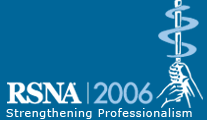
Abstract Archives of the RSNA, 2006
Jianhai Li MD, Presenter: Nothing to Disclose
Unni K. Udayasankar MD, Abstract Co-Author: Nothing to Disclose
Thomas Louis Toth, Abstract Co-Author: Employee, General Electric Company
John L Seamans MS, Abstract Co-Author: Employee, General Electric Company
William Clark Small MD,PhD, Abstract Co-Author: Nothing to Disclose
Mannudeep Karanvirsingh Kalra MD, Abstract Co-Author: Research grant, General Electric Company
Sandra Miller Waldrop PhD, Abstract Co-Author: Nothing to Disclose
et al, Abstract Co-Author: Nothing to Disclose
To determine the effect of a patient centering technique on radiation dose associated with multidetector-row computed tomography (MDCT) of abdomen and pelvis.
A patient centering technique was developed and validated which determines the optimum patient centering with respect to gantry isocenter. This technique uses information from localizer images and provides information about the extent of patient off-centering and adjustment factor to re-center the patient. This study comprised 106 patients (mean age, 51 years; range, 19-84 years, M: F, 61:45) undergoing abdominal CT using z-axis automatic exposure control technique. Each patient was positioned and centered as per scanning protocol. The patient centering technique was used to estimate the patient off-centering and percent dose reduction with optimum re-centering. Data was analyzed using parametric and non-parametric statistical tests.
94.3% (96/106) of patients were not centered accurately in gantry isocenter. Mean distance of off-centering was 21.3mm (range, 5.1-75mm). Mean radiation dose saving with the innovative centering technique for all patients was 11.5±0.76% (range, 2.6-33.2%). There was a strong correlation between off-center distance and percent surface CTDI reduction with re-centering of patients in the gantry isocenter (r²=0.82, p<0.0001).
Improper centering of the patients within the gantry leads to an increase in surface radiation dose. This patient centering technique can help in optimum patient centering and result in up to 33% surface dose reduction.
Application of the centering technique in patients undergoing MDCT scans will result in significantly reduced raditation dose.
Li, J,
Udayasankar, U,
Toth, T,
Seamans, J,
Small, W,
Kalra, M,
Waldrop, S,
et al, ,
Patient Miscentering Increases Surface Dose from Abdominal CT: Can a Patient Centering Technique Help?. Radiological Society of North America 2006 Scientific Assembly and Annual Meeting, November 26 - December 1, 2006 ,Chicago IL.
http://archive.rsna.org/2006/4432990.html

